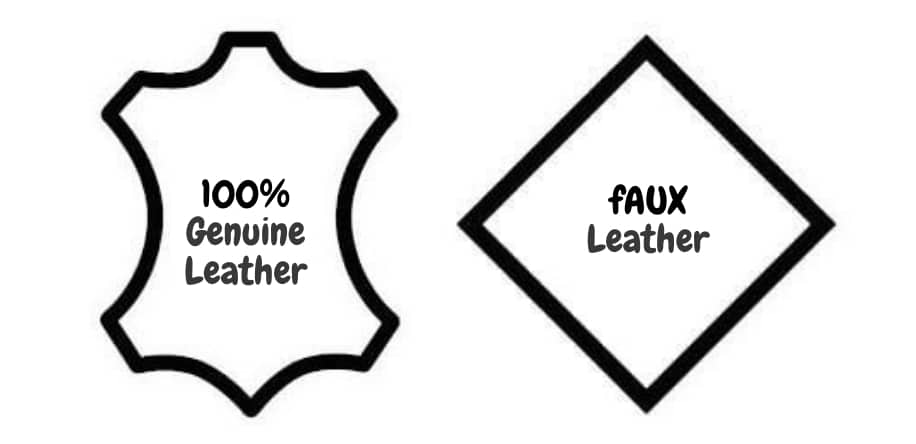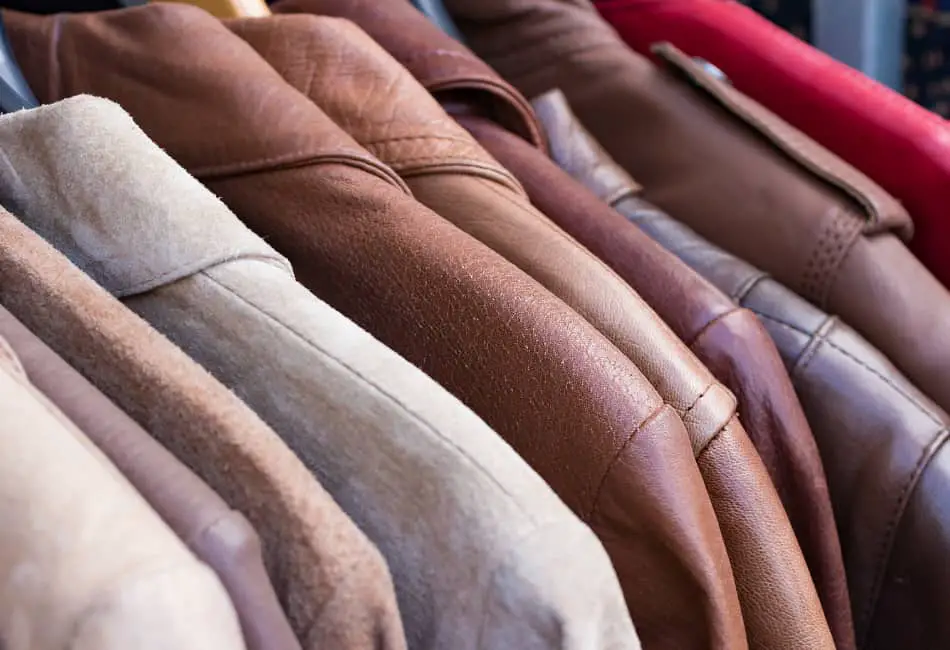Ever heard the phrase “faux leather” and wondered if it is real leather? Well, it’s Not! In this article, I’m going to share with you 8 reasons why faux leather is not real leather and also throw in a few tips and tricks on how to tell the difference between them.
So, is faux leather real leather? Faux leather is not real leather because it is plastic-based (polyurethane or polyvinyl). Faux leather is also not leather because it is non-porous and less durable. The last but not least, faux leather is not real leather because it does not patina over time.
Keep reading this blog post to learn the details on why faux leather is not real leather and how you can tell the difference between real and faux leather.
Reasons Why Faux Leather Is Not Real leather
1. Faux Leather Is Made Of Plastic
The fundamental reason why faux leather is not real leather is that faux leather is a plastic-based product.
Faux leather is often made of a mixture of polyurethane, polyvinyl, and other plastic materials.
The end product is a man-made material that looks exactly like real leather especially if you do not have the technical eye or do not know what to look out for.
Real Leather, on the other hand, is derived from animal skin such as cattle, sheep, goats, etc. Real leather is a by-product of the meat industry.
Real leather is generally the outer covering of the animal. However, there are some exceptions such as suede or nubuck leather.
How To Tell:
One of the easiest ways to know if what’s in from of you is a plastic-based leather product or an animal-based leather product is the symbols below.

If you’re on the market shopping for leather products, be sure to take a look at the tags.
These symbols are commonly found around leather products and accessories or on their labels for shoppers to easily identify the type of leather used.
2. Faux Leather Comes With Impressed Grain Patterns
Another tell-tale sign that your faux leather product is not real leather has to do with the grain pattern or texture on its surface.
Faux leather is often embossed with a grain pattern to make it look like real leather. So, the grain patterns on faux leather will always be consistent and uniform. And the ridges on faux leather will always be very pronounced.
However, although the grains may appear the same, real leather is made up of different surface or grain patterns.
This is because no one real leather is the same as another. There are many factors that determine the surface quality of real leather.
A cow’s skin can have many different pattern types which are determined by age, sex, diet, where the animal was raised.
For example, animals raised in 3rd world countries will have a lot more dents and scars on their skin while animals raised in the USA will have very few.
How To Tell:
One of the key ways to tell if your faux leather product is not real leather will be the lack of variations in its grain pattern.
Real leather, on one hand, will have a lot more natural variations while faux leather will have very a lot of consistent and uniform grain patterns.
3. Faux Leather Does Not Stretch
One of the great characteristics of real leather is that it can be stretched or shrunk to fit your needs. Faux leather on the other hand is not leather because it is not pliable and has little to no elasticity.
The reason for this is that real leather has natural fibers that can be stretched and adjusted. But faux leather does not have this ability because it is made up of plastic-based materials which are non-porous hence cannot be stretched or shrunk.
This means when faux leather is stretched, it will break or crack. Real leather on the other hand when it is stretched will not break or crack but will instead give way to the stretch – especially when wet.
How To Tell:
One of the easiest ways to tell if your faux leather product is not real leather will be by trying to stretch it.
If it feels rigid or provides some resistance when you try stretching it then you know your leather product is made of fake or faux leather.
4.Faux Leather Has Chemical Smell
Faux leather often has a distinct chemical smell that is pungent and can be overpowering if you’re not used to it.
The smell of faux leather is a result of the plastics and chemicals that are used in its manufacturing.
Real leather on the other hand has a distinct leathery or musty smell that is natural and not overpowering.
While this is true in most cases, some real leather also has a chemical smell – especially when new.
Also, some faux leather products are treated with leather conditioners and cleaners to give them the smell of real leather.
How To Tell:
With the above in mind, you can do a simple test to determine if your faux leather product is real or fake.
Simply smell it and you should be able to tell the difference in both smell and texture.
If it smells like plastic or chemicals then you know that your product is made of faux leather while if it has a luxurious smell of rich leathery smell and feel, then you know that your product is made of real leather.
5. Faux Leather Is Not Porous
Part of what makes real leather a great material for many products is that it has porous properties.
Real leather has tiny holes on its surface which gives it a unique breathable quality. The pores on the surface of real leather are the hair follicles where the hair of the animal is used to grow.
This porous property allows real leather to release sweat and moisture while preventing the growth of bacteria or germs.
Faux leather on the other hand does not have pores because it is made of non-porous materials. This makes faux leather less breathable and would not allow the release of sweat or moisture.
This means that faux leather will accumulate more bacteria, germs, and odors than real leather.
How To Tell:
You can tell by simply taking a closer look at the surface of the faux leather product and you will notice that there are no pores or holes on its surface.
Real leather, on one hand, should have pores and will feel more breathable when you touch it.
6. Faux Leather Is Less Durable
Faux leather is made of plastic-based material which is more brittle and less durable than real leather.
This means that faux leather can be easily damaged, peel, or scratched while real leather is more durable and will last longer.
Real leather is very durable and will last for many years while faux leather will only last a few months.
Generally, it is known that real leather will last for about 15 to 20 years while faux leather will only last from three months up to a year.
So the durability of faux leather is nothing like that of real leather.
How To Tell:
Durability is something that can not be easily determined by just looking at a product or touching it.
However, you can tell by the overall construction of the faux leather product – is there any glue or stitching visible?
If there are glue and stitches then your faux leather product is probably not as durable as it may seem.
Real leather products are usually stitched or glued together with durable materials not only because they are not durable but because the general quality of the materials used for real leather goods will simply be high quality just as cheap faux leather will usually have cheap accessories.
7. Faux Leather Is NoT Real Leather Due To The Price You Pay
Faux Leather is not real leather because of the price you pay for it as compared to the price you pay for real leather.
While both faux and real leather may look similar, they are actually very different in terms of the price you pay for them.
Faux leather is cheaper than real leather just because it costs less to manufacture.
The general price for faux leather products is between $30 and $80 while real leather products usually cost between $50 and $200. This includes products such as shoes, handbags, and wallets.
In general, faux leather will have a cheaper price tag than real leather because it is made from plastic-based materials and will not last as long.
Real leather on the other hand is made up of animal skin which has a unique texture and smell that cannot be easily replicated.
How To Tell:
If you find a product that is priced in the same range as faux leather but you think it is real leather because of the smell and texture then it probably isn’t.
Real leather usually has a rustic feel to it and is usually made with high-quality materials that will not easily break or tear.
All in all, faux leather will have a much cheaper price tag than real leather.
8. Faux Leather Does Not Develop Patina
Patina is a thin layer of oils and dirt that builds up on the surface of the leather over time. Patina is the natural process of a material to change color over time.
This usually happens due to exposure to sunlight, oil from your body, dirt from the environment, etc. This patina is unique to most natural materials like wood, real leather, etc.
Faux Leather is not leather because it does not develop a patina with age. What happens to faux leather with age is that it may crack or peel, lose color, and shine.
Faux leather is different from real leather because it does not develop a patina over time due to the materials used to make it.
Real leather will develop a unique patina and look with age which makes it very attractive, unique, and elegant.
How To Tell:
This can be hard to tell if the leather is new. Usually, the patina will occur after the leather has been used for about two months.
However, if you’re getting the leather product second-hand or from a pawn shop, it is more likely that you’ll be able to tell the difference between real leather and faux leather by looking at the patina on the surface.
If the leather has a shiny overly dark look with scuff, dent, or scratches, then it may be real leather. However, if the leather has cracks, then chances are that it is faux leather.
Final Thoughts
Faux Leather is not real leather and there are a lot of reasons to understand why.
So if you’re on the market looking for real leather products, then make sure you know and understand the difference between faux leather and real leather.
This will help you to make a better buying decision and will help you get a high-quality product that is worth the price.

